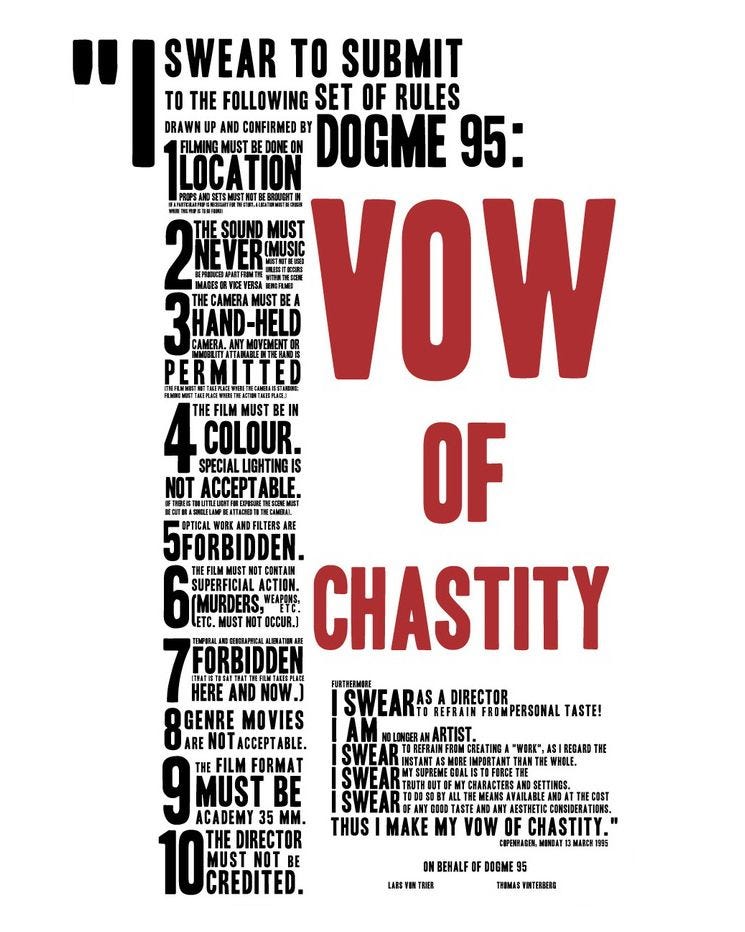The Dogme 95 film movement was a very interesting and short-lived experiment created in the Spring of 1995 by a group of Danish filmmakers lead by Lars Von Trier and Thomas Vittenberg.
The movement was a response to the commercial, hi-tech, and industrialized methods that came to dominate filmmaking, with it’s common menu of special effects, camera rigs, polished lighting, and dependence on sets. True cinematic craft needed to be freed from the fetters of modern studio filmmaking. In short, Dogme 95 was a movement designed to “rescue” cinema from itself.
Trier and Vittenberg wrote a cinematic manifesto they called a “Vow of Chastity.” This manifesto was modeled after Francois Truffaut’s article in Cahiers du cinéma called Une certaine tendance du cinema, which was instrumental in spawning The French New Wave in 1954.
The Vow of Chastity outlined 10 cinematic rules that would define a Dogme 95 film.
Shooting must be performed on location, without providing props or sets that don’t logically exist within that setting
Diegetic sound only. Sounds must never be produced, such as music that does not exist within the scene
All shots must be handheld. Movement, immobility and stability must be attained by hand
The film must be in colour, with no special lighting. If there’s not enough exposure, a single lamp may be attached to the camera
There can be no optical work or lens filters
No ‘superficial’ action (such as staged murders, elaborate stunts etc.)
Geographical alienation is strictly forbidden, meaning the film must take place here and now
No genre movies
Academy 35mm is the only accepted film format
Directors must not be credited
THE DOGME 95 GAUNTLET THROWN DOWN
The Dogme 95 manifesto was made public in Paris at the 100th anniversary of the cinema on March 13, 1995, where Trier was invited to speak at an event called Le cinéma vers son deuxième siècle. When Trier took the podium he expressed to the audience of film aficionados and professionals his disappointment at what film had become.
“It seems to me that in the last 20 years, no, let’s say 10 then, film has been rubbish. So my question was, what can we do about this? And I made some little papers with words on it. It’s called Dogme 95!”
He opened a red brochure, with Dogme 95 printed on the cover, and read it to the audience. 500 copies of the red Dogme 95 pamphlet were distributed to the attendees (someone has said Trier threw the pamphlets into the audience). Dogme 95 was seeded as a movement.
Filmmakers who abide by the Dogme 95 manifesto became part of the “Dogme Brotherhood” and were referred to as “Dogme brethren.”
Filmmaker Harmony Korine joined the brethren, and she wrote:
“In joining the Dogme Brotherhood … I proudly abandon-ed those cinema tactics that I have been brought up in. And in doing this, I succumbed to a religious-like semi-calvinist fervour. But, as when I was a child, the temptation to sin was always a romantic option.”
While many filmmakers bent the rules of the Vow of Chastity, their fervor for the spirit of the rules are ever-present.
The first Dogme 95 film to be produced was Festen , or The Celebration, directed by Thomas Vitterberg is the first, and perhaps, best known film from the Dogme 95 film movement. It won the Jury Prize at the Cannes Film Festival in 1998.
A total of 35 films would be made following the rules of Dogme 95. The last film to be made was Cristiano Ceriello’s Cosi x Caso in 2004.
DOGME INFLUENCED A NEW GENERATION OF FILMMAKERS
Der Dansk Filminsitut (the Danish Film Database) spoke with 3 young filmmakers about how Dogme 95 influenced their filmmaking style.
Samanou Acheche Sahlstrøm, the director of In Your Arms, said–
“I rely on Dogme’s idea of freedom. At film school, we learned certain aesthetic rules of film-making. Dogme made it clear that while you should know these rules, other rules can be just as productive. For me, it highlighted the importance of establishing a framework for my story that made a production possible within a given financial situation.”
Michael Noer, director or R, Northwest, and Key House Mirror, believes rules create emotions. He loved the Dogme films because they —
“–found drama in realism — a feeling I’m not afraid to admit I’ve over-exploited since. Reality rules…. I’m still searching for the extremely dramatic in the ultra-realistic.”
Mads Matthiesen, director of Teddy Bear and The Model, said —
“The Dogme movement’s desire to simplify film production and get closer to the story and the acting is one thing I’ve felt very inspired by in my work. Not to let the technical aspects of the film production gain the upper hand, but remember to let the story and the actors in front of the camera come first.”
The movement might be over, but Dogme’s impact is still being seen.





